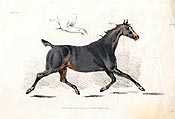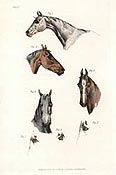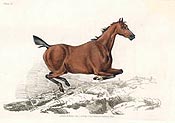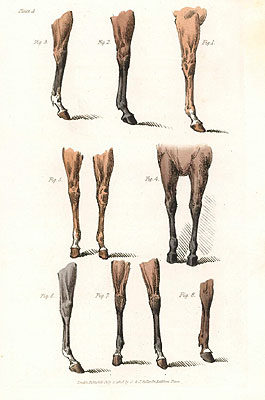|

Grey horse pictures

Composite horse pictures

Bay and chestnut horse pictures
|
Horse Pictures - Fore-legs
Antique pictures of
horses
|
Taken from:
The Beauties and Defects in the Figure of the Horse
Delineated in a Series of Coloured Plates
by H. Alken
Published in London by S. and J. Fuller at the
Temple of Fancy, 34 Rathbone Place - 1816
|

|
|
Notes accompanying this plate
Figure 1 - Is
a fore-leg formed for speed, and perhaps action: but
not calculated for permanency. The plate of the knee
being much lower than it ought to be, the horse must
be considered as a dangerous road animal.
Figure 2 - Is
formed to do much work and last long at it.
Figure 3 - Is
good in substance, but rather too round, and too
straight.
Figure 4 - Is
a pair of legs well formed for strength and action.
Figure 5 -
Displays the front view of legs badly formed, being,
what the dealers call, made like a dancing-master
ought to be: but still, if the toe, or point of the
hoof deviate at all from the straight line, it
should be this way, as the contrary is extremely
dangerous on the road, and indeed any where else.
Figure 6 - A
leg made for neither speed nor power, being flat and
poor in the arm, round and weak in the leg, thin and
long in the pastern and large in the hoof.
Figure 7 - A
pair of legs worse than Figure 5, being weak,
badly formed, and hardly good for anything.
Figure 8 - This
appearance is seldom formed by Nature: it is
occasioned by hard work, straining &c.
|
|
The picture above is an
illustrated plate from the 1816 publication, the inside title page of which
is reproduced here along with the introduction to the book
 "By
a detailed series of graphic and descriptive illustrations, it is the
intention of the Author of this Work to show the good and bad points in
that most useful and noble animal the Horse. He has adopted the mode of
detaching various parts of the subject, because, by comparison of the
distinct appearances, the general impression upon the memory of the
reader is much likely to be much stronger than could result from the
study of any treatise of a less abstracted nature; to understand which,
a knowledge of anatomy, or a constant reference to some scientific work
is indispensable. "By
a detailed series of graphic and descriptive illustrations, it is the
intention of the Author of this Work to show the good and bad points in
that most useful and noble animal the Horse. He has adopted the mode of
detaching various parts of the subject, because, by comparison of the
distinct appearances, the general impression upon the memory of the
reader is much likely to be much stronger than could result from the
study of any treatise of a less abstracted nature; to understand which,
a knowledge of anatomy, or a constant reference to some scientific work
is indispensable.
This Publication is also intended as a
Book of Lessons for such young Artists as are inclined to pursue the
study of the Horse in all the different points of his figure and action.
There is no animal whose countenance
combines such correct and powerful expressions of character. The
physiognomy of the Horse, therefore, illustrating the different passions
to which he is subject, as well as the natural bias of his temper and
disposition, is an important branch of study to gentleman of the turf,
and to young purchasers; for it is generally considered, that to timid
riders and drivers, the temper of the beast is of more consequence than
any bodily blemish.
In this point of view, therefore, the
Author flatters himself that his Work will be found useful; and as his
remarks are the result of the most attentive observation during many
years, entirely devoted to the pleasures of the field, he trusts that
the general principles which he has laid down, as well with respect to
power, strength, and the various points of action as to the
physiognomical character and figure of the horse, will be found fairly
elucidated in the following series." |
|

